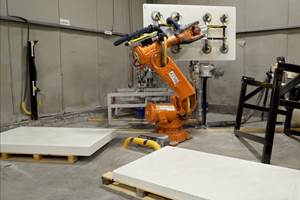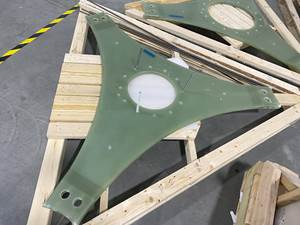Liux is gearing up for serial production of its flax fiber composite-intensive BIG electric vehicle (EV) prototype. Source | Liux
Automotive startup (Alicante, Spain) was founded in 2021 by business partners David Sancho and Antonio Espinosa with the goal of creating recycling solutions within the automotive composites market.
Sancho has a background in automotive design, and says he wanted to leverage his experience to build a more sustainable electric vehicle (EV) that would meet the needs of urban commuters.
The company’s first product, showcased to the composites industry at JEC World 2025, is called BIG (formerly Geko), and is a two-seater EV whose structural components are made primarily from flax fiber and recyclable thermoset resin.
BIG’s doors, fenders, bumpers, tailgate and even the battery enclosure are made via resin transfer molding (RTM) from two layers of Saertex (Saerbeck, Germany) biaxial flax fabric infused with EzCiclo RH512 resin from Swancor (Nantou, Taiwan).
Why these materials? “Flax fiber provides the performance we need, with a low CO2 footprint,” Sancho says. The resin used is a high-performance vinyl/acrylic blend said to contain ≥10% bio-based raw material, and is the latest in Swancor’s EzCiclo product line of recyclable resins.
The use of these materials is said to equate to a reduced CO2 footprint throughout the vehicle’s product life by 40% compared to other EVs, and up to 80% compared to a gasoline SUV.
The first-generation BIG has a range of 170 kilometers per charge — and Sancho notes that the planned next-generation system will have a range of close to 230 kilometers per charge.
How would recycling of a BIG vehicle work in practice? At its end of life (EOL), the vehicle would need to be disassembled and the relevant components returned to one of Swancor’s recycling facilities — the company currently operates recycling lines in Taiwan and China, with a third opening in Romania this year.
Once received by a Swancor recycling facility, the parts would then be cut into smaller pieces, placed into the recycling vessel and subjected to Swancor’s CleaVER liquid at 150°C for 4 hours. This process separates the fiber — which can be remade into new flax yarns — and resin, which results in oligomers that can be modified by Swancor and reused to make new EzCiclo resin. The CleaVER solvent can also be reused for multiple batches, and Swancor claims its process generates no waste liquid or exhaust.
To facilitate the recycling process, Sancho says Liux aims to work with Swancor to develop a full recycling concept and supply chain for EOL vehicles in future.
Liux is working toward production of its first 10 serial units by July of this year. Currently, most of the vehicle components are manufactured by fabricator partners, and then the full vehicles are assembled at Liux’s Alicante facility. All of the design and engineering work is also done in-house by Liux.
The company plans to open a full production facility in Spain in 2026 that will include capacity for RTM manufacture of composite parts as well as vehicle assembly. The company aims to build 2,500 vehicles in 2026, scaling up to 9,000 units per year by 2028.
Related Content
Designing an infused, two-piece composite baseball bat
With its Icon BBCOR bat, Rawlings leveraged its experience in braided fabrics and RTM to create an optimized, higher-performance two-piece design.
Read MoreBallistic protection panels manufacturer relies on automation for high throughput, efficiency
Maine-based CW Top Shops honoree Compotech Inc. recently doubled its manufacturing space and team to produce modular composite panels for defense applications via light resin transfer molding (LRTM).
Read MoreCorebon induction heating
This sidebar to CW’s August 2024 feature article reviews this technology for more efficient composites manufacturing and why it aligns with Koridion active core molding.
Read MoreRTM, dry braided fabric enable faster, cost-effective manufacture for hydrokinetic turbine components
Switching from prepreg to RTM led to significant time and cost savings for the manufacture of fiberglass struts and complex carbon fiber composite foils that power ORPC’s RivGen systems.
Read MoreRead Next
Biomaterials make strides toward composites sustainability
A compilation of trends in development or application of natural fibers, bio-based resins and more showcases industry players, educational institutes and global projects.
Read MoreNatural fiber composites: Growing to fit sustainability needs
Led by global and industry-wide sustainability goals, commercial interest in flax and hemp fiber-reinforced composites grows into higher-performance, higher-volume applications.
Read MoreJEC World 2025 highlights: Evolving recycling and biomaterials technologies
CW technical editor Hannah Mason shares sustainability-focused composites trade show highlights featuring maturation, scale-up, new partnerships, and new technologies in biomaterials and recycling.
Read More



.jpg)






